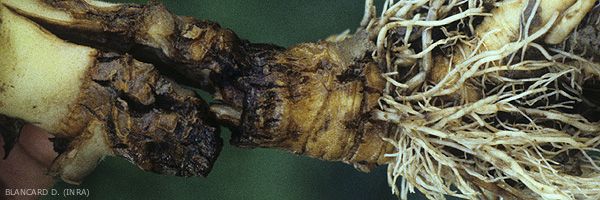
Corky collar disease
Corky lesions (corky collar) at the base of the tobacco stem are occasionally observed in tobacco crops. This phenomenon is quite rare and not much known. These symptoms and their evolution remind those already described in other Solanaceae, such as peppers (capsicum basal necrosis) and tomato (corky collar and pivot of the tomato). The following has been observed:
- A slight chlorosis and wilting of plants during the hottest periods of the day, a slowdown in growth;
- Suberisation and collar rot (whose diameter is sometimes more important) and taproot (primary root) that have more or less important bursts (figures 1-3). These are partly due to loss of elasticity of the cortex, which after suberisation, seem to have trouble to grow along with the stem. They sometimes allow the secondary micro-organisms to proliferate and cause browning of deep tissues and the most superficial vessels;
- The collar weakens and becomes much more brittle, resulting in fall of plants
As with other Solanaceae, the origin of this disease does not seem to be, in all cases, parasitic. It could be related to a repeated micro-asphyxia occurring rather early after planting. Its expression is enhanced by the implementation of agricultural practices causing water stagnation. Repeated micro-asphyxia provoke superficial alterations, and may induce corky scar tissues at the submerged parts of plants. Excessive salinity may enhance the appearance of this non-parasitic disease.





